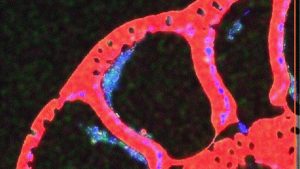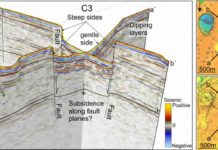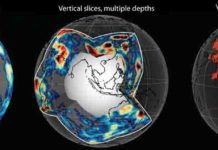
Methane is stored under the sea floor, concentrated in form of hydrates, crystalline ice structures that stay stable under high pressure and in low temperatures.
Several studies suggest that as the ocean warms, the hydrates might melt and potentially release methane into the ocean waters and atmosphere. This potent climate gas is profusely leaking from the seafloor in an area offshore western Svalbard, which is close to the gas hydrate stability zone.
There, scientists have discovered over 250 methane flares in water depths from 90 to 240 meters.
“Previous studies indicate that these seeps could be linked to gas hydrate dissociations. We suspected that dissociation of gas hydrate is not the primary control on seafloor methane seepage. We suggest that there is a strong lithological control on methane seepage.” says Dr. Giuliana Panieri, scientist at CAGE.
Lithology is physical characteristics of a given geological feature, such as texture, composition or size of the grains in a sediment.
Giuliana Panieri is the first author of a study published in Geochemistry, Geophysics, Geosystems. The study examines geochemistry of foraminifera and other proxies as a record of methane seepage in an area of ongoing ocean warming.
Hydrates destabilised as the ice retreated
The study focused on two cores that were collected from sediments at present day seeps off Western Svalbard. There methane hydrate is hypothesised to have destabilised within the last 30 years.
“ In addition two other cores were collected from shallower water depths, which would have been within the stability zone for gas hydrate in the past, As the last ice age ended, some 11000 years ago, the hydrates that were stable under the ice sheets for millennia started to dissolve as the ice sheets disappeared. Methane would have leaked out at some point in this location after the last glacial maximum. But we found no evidence of past methane seepage within the foraminifera tests and other proxies in sediments recovered from cores at the shallower depths,” says Panieri.
Foraminifera are single celled organisms that can be found in all the oceans in the world. If you have walked on a beach, the odds are that you have been walking on billions upon billions of foraminifera tests.
These tests are extremely sensitive to environmental changes. By reading the isotopic composition of the fossilised tests, the scientists can determine whether methane was released when the test was forming or immediately after.
In addition to foraminifera Panieri and her colleagues studied sediment geochemistry and magnetic susceptibility in the four sediment cores they collected in the area.
Sediments stand in the way
This implies that melting of gas hydrate is not the primary control on seafloor methane seepage on the upper continental margin.
“We suggest that there is a strong lithological control on methane seepage. This means that the sediment lithology determines whether the methane will escape or not.“ says Panieri.
A more extensive coring survey is required to determine if seafloor seepage of methane has always been absent at these water depths. Also more seismic surveys need to be conducted to determine the links between the sediment properties and the gas migration pathways.
“As Arctic Ocean bottom waters continue to warm, such surveys are imperative to calculate the potential for methane release to the water column possibly due to melting of the hydrate.”
Reference:
Giuliana Panieri, Carolyn A. Graves, Rachael H. James. Paleo-methane emissions recorded in foraminifera near the landward limit of the gas hydrate stability zone offshore western Svalbard. Geochemistry, Geophysics, Geosystems, 2016; 17 (2): 521 DOI: 10.1002/2015GC006153
Note: The above post is reprinted from materials provided by University of Tromso (Universitetet i Tromsø – UiT).










